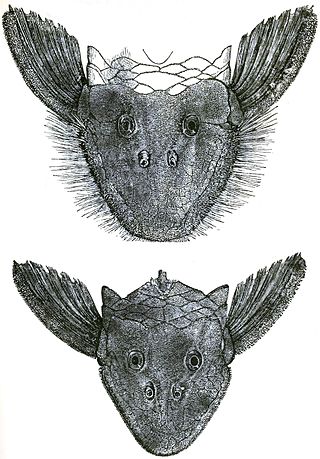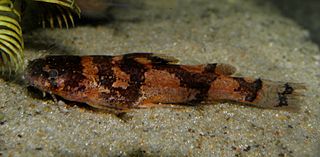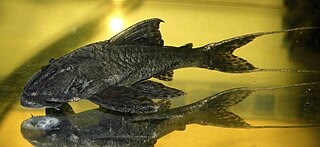
Ancistrus is a genus of nocturnal freshwater fish in the family Loricariidae of order Siluriformes, native to freshwater habitats in South America and Panama. Fish of this genus are common in the aquarium trade where they are known as bushynose or bristlenose catfish. In the aquarium hobby they are often referred to as bushynose or bristlenose plecos instead, but this may lead to confusion as "pleco" usually is used for Hypostomus plecostomus and its allies and is often used as a catchall term for any loricariids remotely resembling that species.

The Amazon basin is the part of South America drained by the Amazon River and its tributaries. The Amazon drainage basin covers an area of about 7,000,000 km2 (2,700,000 sq mi), or about 35.5 percent of the South American continent. It is located in the countries of Bolivia, Brazil, Colombia, Ecuador, Guyana, Peru, Suriname, and Venezuela, as well as the territory of French Guiana.

Hypostomus is a genus of catfish in the family Loricariidae. They are native to tropical and subtropical South America. H. plecostomus is the popular freshwater aquarium fish formerly known as Plecostomus plecostomus. The taxonomic structure of the Loricariidae is still being expanded by scientists. Hypostomus is a highly species-rich and widely distributed catfish genus.

Otocinclus is a genus of catfish in the family Loricariidae native to South America, commonly known as "dwarf suckers" or "otos". This genus, like other loricariids, is characterized by rows of armour plating covering the body, as well as the underslung suckermouth. They are generally small in size; O. tapirape is the smallest of the species (2.4 cm), while O. flexilis is the biggest (5.5 cm). These species have adaptations that allow them to breathe air. A duct forms at the junction between the esophagus and the stomach and expands into an enlarged, ring-like diverticulum, characteristic of this genus, which allows air-breathing. Otocinclus are popular aquarium fish, and they are often purchased as algae eaters. It is difficult to breed them in captivity, and only wild caught Otocinclus are available to hobbyists. This genus is widely distributed east of the Andes of South America, throughout the lowlands from northern Venezuela to northern Argentina, but are generally absent from the Amazon and the Orinoco lowlands.

The Pimelodidae, commonly known as the long-whiskered catfishes, are a family of catfishes.

Aspidoras is a genus of catfishes of the family Callichthyidae from Brazil.

Pseudancistrus is a genus of suckermouth armored catfishes native to South America.

Rineloricaria is a genus of freshwater tropical catfish belonging to the family Loricariidae. They are commonly called whiptail catfish because of the long filament that grows out of the tip of the caudal fin that is characteristic of the genus. With the exception of R. altipinnis from Panama, they are native to the rivers of northern and central South America. Some species are regularly seen in the aquarium trade.

Microglanis is a genus of fish in the family Pseudopimelodidae native to South America. This genus has the widest distribution within its family, with species ranging from the Guianas to Venezuela; western slope of the Andes in Ecuador and Peru to the Río de La Plata basin in Argentina. They occur eastward to the Orinoco and Amazon basins. It is also present in the eastern coastal rivers of Brazil.

Peckoltia is a genus of small South American armored suckermouth catfishes. Many of these fish are popular aquarium fish.

Hemiancistrus is a genus of suckermouth armored catfishes. These species are native to South America. The taxonomy of this genus is complex and unclear, and major work has to be done. Many of these fish are popular aquarium fish.

Pimelodus is a genus of fish in the family Pimelodidae native to Central and South America.

Parotocinclus is a genus of fish in the family Loricariidae native to South America. This genus is distributed through almost all hydrographic systems in South America from the Guyana Shield drainages and Amazon Shield tributaries to the coastal drainages of eastern and southeastern Brazil, including the rio São Francisco basin. Most species have the caudal peduncle oval in cross section. It has been found that Characidium species may interact with P. maculicauda. The small Characidium will follow grazing P. maculicauda, which release particulate matter dislodged from the catfish's foraging.

Bunocephalus is a genus of banjo catfishes from South America. It is found in Magdalena, Orinoco, Amazon, Paraguay-Paraná, and São Francisco Rivers. It is also the only aspredinid genus found west of the Andes, found in the Atrato, San Juan, and Patía Rivers. This genus is a part of the family Aspredinidae, known as banjo catfishes for their large, flattened heads and slender tails that give the appearance of a banjo. Most species exhibit cryptic coloration, and the same holds true among Bunocephalus species. The skin is completely keratinized and is covered by large, unculiferous tubercles. Bunocephalus species may reach up to 13 centimetres SL.

Peckoltia pankimpuju is a species of armored catfish from the family Loricariidae, native to the Marañón River in the upper Amazon basin of Peru. It is commonly called the coal pleco, Peruvian lyre-tail, and L350 under the L-number code. It reaches up to about 40 cm (16 in) in length.
Loricariichthys edentatus is a species of catfish in the family Loricariidae. It is native to South America, where it occurs in the lower Uruguay River basin in Entre Ríos Province in Argentina, and also in Brazil. It has no teeth on the premaxilla, a unique feature in the genus Loricariichthys. The species reaches 11.5 cm in standard length and is believed to be a facultative air-breather.
Ancistomus micrommatos is a species of catfish in the family Loricariidae. It is a freshwater fish native to South America, where it is known only from the Tocantins River basin in Brazil. The species reaches 11.9 cm in standard length. Although originally described as a species of Hemiancistrus in 2003, a 2015 review conducted by Jonathan W. Armbruster, David C. Werneke, and Milton Tan listed the species as valid within Ancistomus. The same review also reported that no characteristics were found to separate A. micrommatos from its congeners A. spilomma and A. spinosissimus, indicating that the three may actually all be the same species.
Ancistomus spilomma is a species of catfish in the family Loricariidae. It is native to South America, where it is known only from the Tocantins River basin in Brazil. The species reaches 14.2 cm in standard length. Although originally described as a species of Hemiancistrus in 2003, a 2015 review conducted by Jonathan W. Armbruster, David C. Werneke, and Milton Tan listed the species as valid within Ancistomus. The same review also reported that no characteristics were found to separate A. spilomma from its congeners A. micrommatos and A. spinosissimus, indicating that the three may actually all be the same species.
Ancistomus spinosissimus is a species of catfish in the family Loricariidae. It is a freshwater fish native to South America, where it is known only from the upper and middle Tocantins River basin in Brazil. The species reaches 12.7 cm in standard length. Although originally described as a species of Hemiancistrus in 2003, a 2015 review conducted by Jonathan W. Armbruster, David C. Werneke, and Milton Tan listed the species as valid within Ancistomus. The same review also reported that no characteristics were found to separate A. spinosissimus from its congeners A. micrommatos and A. spilomma, indicating that the three may actually all be the same species.
Ancistomus snethlageae is a species of catfish in the family Loricariidae. It is native to South America, where it occurs in the Tapajós basin in Brazil. The species reaches 22 cm in total length. Although originally described as a species of Ancistrus in 1911 by Franz Steindachner and subsequently reclassified in the genera Hemiancistrus, Lasiancistrus, and Peckoltia, a 2015 review conducted by Jonathan W. Armbruster, David C. Werneke, and Milton Tan listed the species as valid within Ancistomus.














